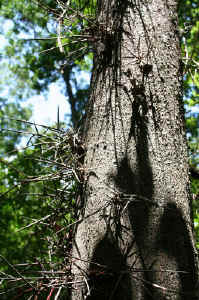| ESA
meeting 2006 |
Lee
Frelich |
| Aug
10, 2006 14:16 PDT |
ENTS:
This afternoon I returned to Minneapolis after attending the
Ecological
Society of America meeting in Memphis TN. It was about 99
degrees there
each day with dewpoints in the 70s. People from all over the
world and the
rest of the U.S. thought the weather was hideous, but after the
July we had
in Minneapolis, it felt normal to me. The Mississippi River
looks to be 20
or 30 feet below normal in Memphis, as a severe drought persists
throughout
most of the river's watershed.
8:00 to 11:30 Monday morning I was the moderator of a session on
Alteration
of North American forests by invasive invertebrates, which I
organized with
David Foster. Except that the computer died once, it went very
well with
good attendance when you consider that we were competing with 20
other
sessions. Emerald ash borer, Hemlock wooly adelgid, European
earthworms in
northern forests, and Asian earthworm invasion in the Smokies
were covered
as well as policy responses and breeding resistant varieties of
trees.
Tuesday Tom Diggins, two of his students, Don Bragg and I went
on an
impromptu field trip to the site where the Ivory Billed
Woodpeckers may have
been discovered, where we saw Cypress trees 600-800 years old.
There are a
lot of strange tree species there, such as water locust, which
has hundreds
of 6 inch spines sticking out of the trunk in all directions.
I'll bet not
many people actually measure the dbh of a water locust.

Water Locust with spines - photo by Don Bragg
Tom and
Don will
report on the 33 foot cbh tree we measured in the swamps of
Arkansas.
We also saw Crowley's ridge, where unhappy looking sugar maple
were
growing, with leaves half the normal size, mixed with oaks,
hickories, and
beech. We also visited a place with saline soils the texture of
flour,
forested with stunted post oaks. It was a great day, since one
field trip
is worth 1000 presentations at the ESA meeting, and I only had
three
chigger bites, a low number probably attributable to the
drought.
People in Memphis were extremely friendly, although they moved
at a speed
which appeared to someone from Minnesota to be in suspended
animation. Although I thrive on the Manhattan-like bustle of
Minneapolis,
with its skyscraper lined canyons filled with thousands of
people darting
in every direction at high speed, and probably would not be one
of the top
scientists if I did not live in such a place, it is still fun to
occasionally visit a small town like Memphis with charming old
buildings,
brick sidewalks, and streetcars. Willow oak trees are everywhere
along the
streets. Too bad that species cannot grow in Minneapolis at this
time
(maybe in 20 years with a little more climatic warming?). I
returned to a
newly green Minneapolis, the trees and grass having responded to
the heavy
drought breaking rains that occurred just before I left.
Lee
|
| Re:
ESA meeting |
Lee
E. Frelich |
| Aug
11, 2006 08:08 PDT |
Bob:
Actually, the 33 foot cbh tree is not a bald cypress. You will
have to
remain in suspense until Tom or Don post something about it.
Lee
| |
At
06:29 AM 8/11/2006, Robert Leverett wrote:
Lee,
Congratulations! We can't
wait to hear about the 33-foot CBH bald
cypress.
|
|
| Water
tupelo!!!!! |
Thomas
Diggins |
| Aug
12, 2006 05:38 PDT |
Yep,
You guys got it; it was a water tupelo.

Tom Diggins measuring the Water Tupelo
- photo by Don Bragg
CBH = 31' 3"
height = 74.9' (lost most of its top)
crown = 56' (ditto)
AF points = 464
It's REALLY close to national champ status, so if there is any
more in
the height and/or crown spread (Don's gonna revisit the tree),
OR if
the co-champs in VA are even slightly over-measured we might
have it.
Thanks again to Don for an absolutely awesome field trip. Just
shows
again why ENTS is tops - unquestionably one of the premier
nature
organizations in North America!
Tom
|
| Re:
ESA meeting |
Jess
Riddle |
| Aug
12, 2006 13:24 PDT |
Hello Lee,
Good to hear your presentation went well, and that others were
taking
notice of the issue.
Water locust is certainly a strange species, but not too bad to
measure. The larger ones seem to have smoother trunks, but you
have
to watch out for the occasional basal sprouts, which are nothing
but
thorns.
The maple you describe sounds like Florida/southern sugar maple.
The
range maps I looked at showed neither sugar maple nor Florida
maple in
that area, but Will and I saw abundant Florida maple at Meeman-Shelby
State Park. Florida maple commonly associates with the species
you
mentioned, has much smaller but similarly shaped leaves to sugar
maple, and often has smoother park than sugar maple.
Thanks for the report. Sounds like a fun and varied trip.
Jess
|
| RE:
Water tupelo!!!!! |
Marcas
houtchings |
| Aug
12, 2006 15:04 PDT |
Hey everyone this is Marcas from Congaree.. great tree Tom. I
seen the
National Champ water tupelo in VA. this tree is in some type of
slough they
mearsure the tree when the water was way low in a wetland both
the Co-Champ
and the National are in the same place.
|
|